Balbharti Maharashtra State Board Class 10 English Solutions Unit 3.3 Stephen Hawking Notes, Textbook Exercise Important Questions and Answers.
Class 10 English Chapter 3.3 Question Answer Maharashtra Board
Stephen Hawking Poem 10th Std Question Answer
Question 1.
Get into pairs and match the prominent personalities with the disabilities they had :
| ‘A’ | ‘B’ |
| (1) John Milton | (a) The great German composer and musician who became deaf at the age of 28 years. |
| (2) Beethoven |
(b) The great English poet who became blind at the age of 43 years. |
| (3) Stephen Hawking | (c) An American entrepreneur, animator, voice actor, had a learning disability. |
| (4) Walt Disney | (d) Famous scientist of the 20th century who was paralyzed. |
| (5) Albert Einstein | (e) Great inventor who has over 1000 patents had a learning disability and became deaf. |
| (6) Thomas Edison | (f) Great 20th Century scientist and noted physicist who had a learning disability. |
| (7) Hellen Keller | (g) Dancer whose leg had to be amputated because of an accident. |
| (8) Sudha Chandran | (h) Was blind and deaf. |
| (9) Tanay Grey-Thompson | (i) Had polio and was elected as the President of the United States for four terms. |
| (10) Franklin Roosevelt | (j) Is a wheelchair racer. |
Answer:
| A | B |
| (1) John Milton | (b) The great English poet who became blind at the age of 43 years. |
| (2) Beethoven | (a) The great German composer and musician who became deaf at the age of 28 years. |
| (3) Stephen Hawking | (d) Famous scientist of the 20th century who was paralyzed. |
| (4) Walt Disney | (c) An American entrepreneur, animator, voice actor, had a learning disability. |
| (5) Albert Einstein | (f) Great 20th Century scientist and noted physicist who had a learning disability. |
| (6) Thomas Edison | (e) Great inventor who has over 1000 patents had a learning disability and became deaf. |
| (7) Hellen Keller | (h) Was blind and deaf. |
| (8) Sudha Chandran | (g) Dancer whose leg had to be amputated because of an accident. |
| (9) Tanay Grey-Thompson | (j) Is a wheelchair racer. |
| (10) Franklin Roosevelt |
(i) Had polio and was elected as the President of the United States for four terms. |
Question 2.
Word Building.
(a) Reduplication : The root/stem of a word is repeated exactly the same or with a slight change.
For example,
- tweet-tweet,
- pitter-patter,
- chit-chat,
- bang-bang,
- riff-raff.
Answer:
(a) Reduplication : bow-wow; hee-haw; cheep! cheep; chomp-chomp; ping-pong
(b) Blending : Parts of two or more words combine to form a new one.
For example,
- breakfast + lunch = brunch
- smoke + fog = smog
- motor + hotel = motel
Answer:
(b) Blending : bionic, carjack, Chunnel, cineplex, cyborg, emoticon, infotainment, internet, liger (lion + tiger), netizen, telethon, vidiot, workaholic
(c) Clipping : Reducing a word to one of its syllables or a part of it.
For example, l Mathematics – Maths
- Advertisement – Ad
- Laboratory – Lab
Answer:
(c) Clipping : exam, gym (gymnasium), ‘flu (influenza), gas (gasoline), memo (memorandum)
(d) Acronym : Words formed from the first letter of each of the words involved.
For example, l radar, scuba, Unicef, Nasa
- BBC, CID, USA, ATM, VIP
- DOB, KYC, PM, GN, TY etc.
Answer:
(d) Acronym : laser, CD-ROM, IOU, K9, PIN
In your notebook, write five examples of each of the above types of word-building devices. (You may take the help of a Dictionary/Internet)
![]()
Night of the Scorpion Class 10 English Workshop Questions and Answers Maharashtra Board
Question 1.
Observe the time line and search the occurances according to it. Prepare a chart.
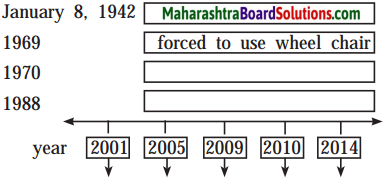
Answer:
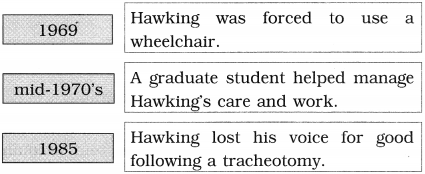
Question 2.
Make a list of books written by Stephen Hawking.
| Name of the book | What’s in it? (topics covered) | His contribution to the world |
| 1. ………………………….. | (a) ………………………….. | |
| 2. ………………………….. | (b) ………………………….. | |
| 3. ………………………….. | (c) ………………………….. | |
| 4. ………………………….. | (d) ………………………….. |
Answer:
| His Name of the What’s in it? | contribution book (topics covered) | His contribution to the world | |
| 1. A Brief History of Time | overview of space and time, existence of God and the future | an account of cosmology for the masses | |
| 2. The Universe in a Nutshell | guide to cosmology’s big theories | illustrated, easier to understand | |
| 3. A Briefer History of Time | touched upon the newest developments in the field like the String theory | simplified the original work’s core concepts | |
Question 3.
Make a list of Hawking’s physical inabilities after 1963.
(a) …………………………..
(b) …………………………..
(c) …………………………..
(d) …………………………..
(e) …………………………..
(f) …………………………..
Answer:
Hawking’s physical inabilities after 1963
(a) could not go anywhere except on a wheelchair
(b) an ever-worsening physical state
(c) needed someone 24/7 to manage his care and. work
(d) except for feeding himself and getting out of bed, had need of assistance for virtually everything else
(e) speech increasingly slurred, finally lost his voice for good
(f) ability to do his work in peril
![]()
Question 4.
Shape your mind. Complete the network of cluster diagram with the name of great personalities and their contribution.
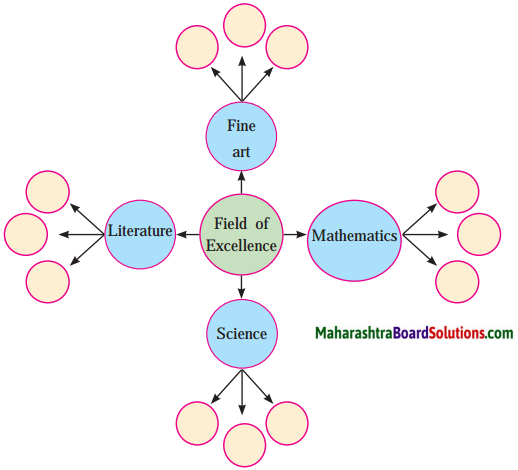
Answer:
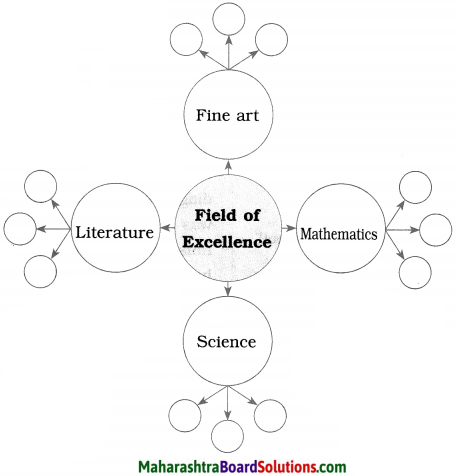

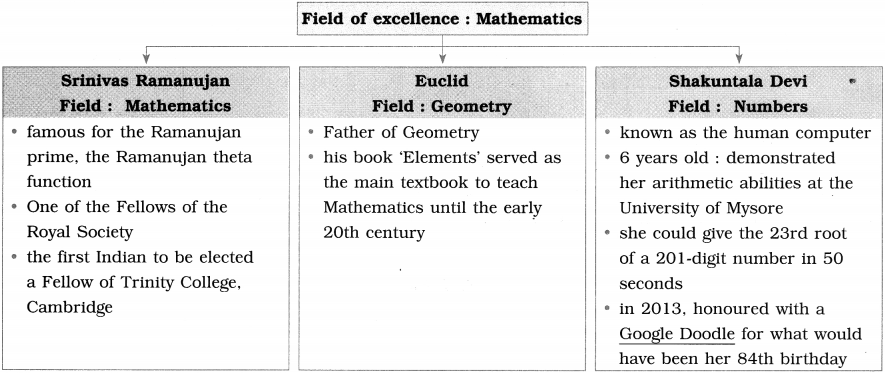
![]()

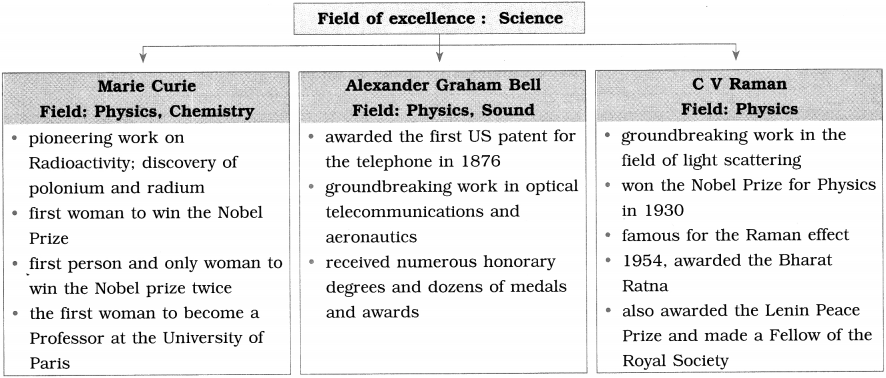
Question 5.
Complete the following web.
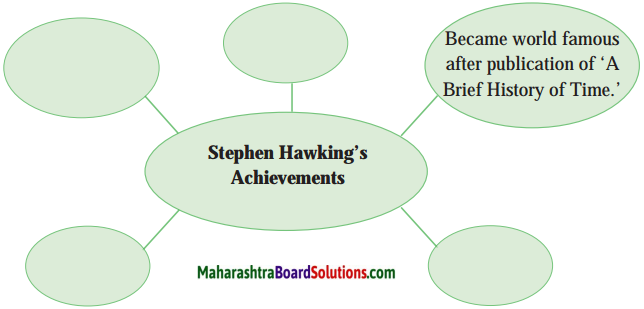
Answer:
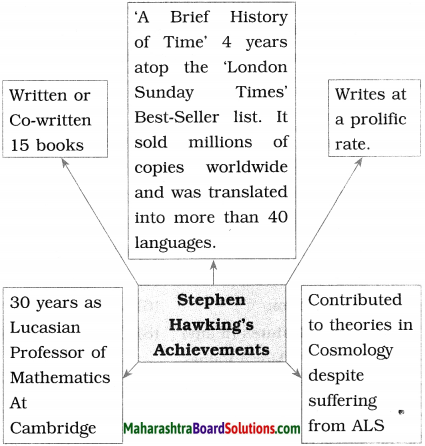
Question 6.
Explain how the life of Stephen Hawking proves the proverb ‘Every cloud has a silver lining’. Write it down in your notebook.
Answer:
Every cloud has a silver lining.
This proverb ‘Every cloud has a silver lining’ means that you should never feel hopeless because difficult times always lead to better days. Difficult times are like dark clouds that pass overhead and block the sun. But at the same time, on the outer edge of the clouds you will invariably observe a silver lining that provides some measure of light and hope.
The problems and difficulties that we face in life are like those dark clouds. Stephen Hawking started experiencing problems with his health while he was barely 21, a student at Oxford. On occasion he would trip and fall, or slur his speech. Later on, he was diagnosed with ALS, Amyotrophic Lateral Sclerosis. It was a disease in which the nerves that controlled his muscles were shutting down. He was given two and a half years to live. But as we know -he went on to live more than a half century beyond.
Thanks to an early diagnosis, advanced medical treatment and complete support from family, friends and students, he lived a full life and made major contributions to existing theories in physics and cosmology. These, in fact, were the silver linings that brightened what would otherwise have been a lacklustre life.
The life of Stephen Hawking proves that even though the difficulty we face might seem enormous, there is always hope, there are always ways to circumvent them and to keep on achieving and contributing to the world.
![]()
Question 7.
Do you agree or disagree with the following statements? Justify your stand/answer by quoting a line from the text.
(a) Stephen Hawking was diagnosed with Alzheimer’s disease.
(b) Hawking believed that man cannot live on other planets in the future.
(c) Though Hawking lost control over his body, he writes with a prolific rate with the help of assistants.
(d) Hawking has written or co-written more than 25 books.
Answer:
(a) No, I do not agree.
The line from the text justifying this stand is Eventually, however, doctors did diagnose Hawking with the early stages of ALS.
(b) No, I do not agree.
The line from the text justifying this stand is He’s convinced that time travel is possible and that humans may indeed colonize other planets in the future,
(c) Yes, I do agree.
The line from the text justifying this stand is Through the program and the help of assistants, Stephen Hawking has continued to write at a prolific rate.
(d) No, I do not agree.
The line from the text justifying this stand is Over the years, Stephen Hawking has written or co-written a total of 15 books.
Question 8.
The following incidents in Stephen Hawking’s life are given in jumbled order. Arrange the incidents in proper sequence as per their order of occurrence in Hawking’s life.
(a) Hawking’s book ‘The Universe in a Nutshell’ offered an illustrated guide to cosmology’s big theories.
(b) Hawking published the book ‘A Brief History of Time’ that offered an overview of space and time.
(c) Hawking was unable to attend a conference in Arizona.
(d) Hawking was diagnosed with ALS while studying cosmology at the University of Cambridge.
(e) Hawking published ‘A Brief History of Time’ that contained the newest development.
Answer:
(c) Hawking’s book ‘The Universe in a Nutshell’ offered an illustrated guide to cosmology’s big theories,
(d) Hawking published the book ‘A Brief History of Time’ that offered an overview of space and time.
(b) Hawking was unable to attend a conference in Arizona.
(a) Hawking was diagnosed with ALS while studying cosmology at the University of Cambridge.
(e) Hawking authored ‘A Briefer History of Time’ that contained the newest developments.
![]()
Question 9.
Fill in the blanks with the proper form of the Verbs as per the Subject :
(1) Mother ………………………………… a good meal. (cook/cooks)
(2) Mother and her daughter ………………………………… a good meal. (cook/cooks)
(3) The rise and fall of the Empire ………………………………… recorded in History. (is/are)
(4) Neither Ritesh nor Alok ………………………………… well. (play/plays)
(5) Either of the two ………………………………… guilty. (is/are)
(6) Everyone ………………………………… mistakes. (make/makes)
(7) That news ………………………………… published today. (is/are)
(8) Eight lakh rupees ………………………………… a big amount. (was/were)
(9) The Committee ………………………………… approved of it. (has/have)
(10) The cost of all the goods ………………………………… risen. (has/have)
Answer:
(1) cooks
(2) cook
(3) is
(4) plays
(5) is
(6) makes
(7) is
(8) was
(9) has
(10) has
Question 10.
From the following sentences, underline the Nouns and encircle their Determiners that specify the noun in a noun phrase.
(articles/possessive pronouns/demonstratives or quantifiers)
(1) He lost his voice for good.
(2) Over the years, Hawking has written 15 books.
(3) These three books articulate his search for science’s Holy Grail.
(4) A few events prevented him from despondency.
(5) That dream made him realize it.
Answer:
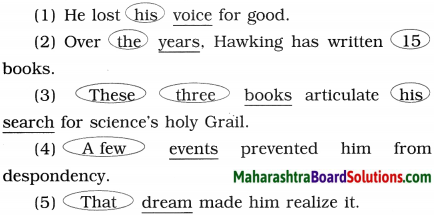
Question 11.
Complete the information from following graphic organiser and prepare summary.
Summary Maker
Title of the text :
(a) Name of the personality : ………………………………………………..
(b) Age : ………………………………………………..
(c) Books (As Author) : ………………………………………………..
(d) Field of Excellence : ………………………………………………..
(e) Achievements : ………………………………………………..
Answer:
| Title of the text | Stephen Hawking |
| Name of the personality | Stephen Hawking |
| Age | born 8 January 1942 |
| Books as author |
|
| Film | ‘The Theory of Everything’ |
| Field of excellence | Theoretical Physics, Cosmology |
| Achievements | Albert Einstein Award, 1978; Co-founder of Microsoft Research |
Question 12.
You have come to know from the text that ‘The Theory of Everything’ is a film describing the life and work of Stephen Hawking. Watch the film on internet and write a complete review of it. You can take help of the following points while writing the review of the film.
(1) Title
(2) Characters
(3) Story
(4) Dialogues
(5) Picturisation
(6) Music
(7) Special features (if any)
(8) Opinion / Views
(9) Message/Moral values.
Answer:
The Theory of Everything – Movie Review
The movie ‘The Theory of Everything’ is based on ! the life of Stephen Hawking. He was diagnosed with ALS at the age of 21, but because of the love of fellow Cambridge student, Jane Wilde, whom he married, he went on to secure achievement after achievement and began to be called the successor to Einstein.
He and Jane defy terrible odds and break new ground In the fields of medicine and science, achieving more than either could hope to Imagine. Hawkings physical decline weakens his already frail body. His mind, on the other hand, remains sharp, always in pursuit of that single equation that would explain the elusive ‘Theory of Everything’. Right up to his mid-seventies, Stephen Hawking has no plans to retire.
The dialogue smoothly carries the narrative forward, at times Indulging In monosyllabic repartee, which, at times, provides crisp tongue-in-cheek humour. It is a very enjoyable film. It is tasteful and engaging and beautiful visually.
The music, which is quite haunting, was nominated for the best musical score at the Oscars.
The film has been criticised for harping on the theme of ‘Time’ throughout, and for being too sentimental!
However, its message that a person can accomplish much in one’s lifetime despite being afflicted with a severe physical disability is universally relevant. Moral values of love and loyalty permeate the film and thus makes it a’treat to watch.
![]()
Question 13.
Answer in one word
(1) At what age was Stephen diagnosed with amyotrophic lateral sclerosis?
(2) Over the years, how many books has Stephen written or co-written?
(3) When did Stephen catapult to international prominence?
(4) In which year was his life story depicted?
Answer:
21
15
1988
2014
Question 14.
(a) Hawking’s book ‘A Brief History of Time’ spent more than four years atop the ‘London Sunday Times’.
Answer:
(a) Hawking’s book ‘A Brief History of Time’ spent more than four years atop the ‘London Sunday Times’.
Question 15.
Observe the timellne and search from the passage the occurrences according to It. (The answers are given directly and underlined.)
Answer:
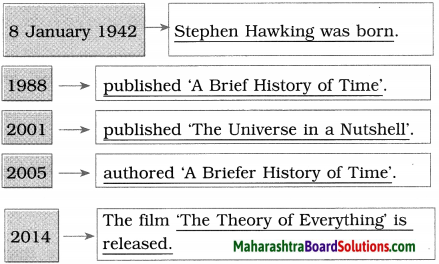
Question 16.
Complete the table with relevant information about Hawking: (The answer is given directly.)
Answer:
| Books | Films |
| (1) A Brief History of Time | The Theory of everything |
| (2) The Universe in a Nutshell | |
| (3) A Briefer History of Time |
Question 17.
Write from the passage words for
(a) status
(b) summary
(c) people
(d) immediate.
Answer:
(a) status – prominence
(b) summary – overview
(c) people – masses
(d) immediate – instant.
![]()
Question 18.
Find out the antonyms from the passage for the following
(i) worst
(ii) exclude
(iii) duplicate
(iv) oldest
Answer:
(i) worst x best
(ii) exclude xinclude
(iii) duplicate x original
(iv) oldest x newest
Question 19.
(1) He was diagnosed with amyotrophic lateral sclerosis. (Rewrite using the present perfect tense of the underlined part.)
Answer:
He has been diagnosed with amyotrophic lateral sclerosis.
Question 20.
It has sold millions of copies worldwide and been translated into more than 40 languages. (Change into a simple sentence)
Answer:
Having sold millions of copies worldwide, it has been translated into more than 40 languages.
Question 21.
The short informative book became an account of cosmology. (Add a question tag.)
Answer:
The short informative book became an account of cosmology, didn’t it?
Question 22.
Stephen Hawking wps a versatile personality. Justify.
Answer:
Stephen Hawking was a versatile personality. He has not only done groundbreaking work in physics and cosmology but also written or co-written 15 books. He worked as a professor of mathematics for a long time. He used to attend various conferences and could think in 11 dimensions.
Question 23.
Fill in the blanks (The answers are given directly and underlined.)
(a) Hawking claimed that he could think in …………… dimensions.
(b) ……………. is the study of the big. …………….. is the study of the small.
(c) ………………. is a single unifying theory that can combine cosmology with quantum mechanics.
Answer:
(a) 11
(b) Cosmology, Quantum Mechanics
(c) Science’s Holy Grail
![]()
Question 24.
*(1) Record the occurrence according to the time chart (The answer is given directly and underlined.)
Answer:

Question 25.
Complete the table
Answer:
| Name of Hawking’s book | Central Idea | Conclusion |
| The Grand Design | God could not have created the universe. | The Big Bang was the inevitable consequence of laws of physics and nothing more. |
Question 26.
Complete the following: What is Hawking convinced of?
Answer:
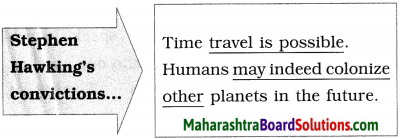
Question 27.
(1) Write words ending in ‘-ity’ using the words given
(a) unify
(b) possible
(c) compatible
(d) inevitable.
Answer:
(a) unify – unity
(b) possible – possibility
(c) compatible – compatibility
(d) inevitable – inevitability.
Question 28.
Match the words in Column A with their meanings in Column B
| ‘A’ | ‘B’ |
| (a) unifying | (a) agreeable |
| (b) compatible | (b) unavoidable |
| (c) inevitable | (c) unplanned |
| (d) spontaneous | (d) joining |
Answer:
| (a) unifying | (d) joIning |
| (b) compatible | (a) agreeable |
| (c) inevitable | (b) unavoidable |
| (d) spontaneous | (c) unplanned |
![]()
Question 29.
Write sentences using the given phrases
(a) lay out
(b) be the consequence of
(c) is compatible with.
Answer:
(a) I want you to lay out your plans for the future before you graduate.
(b) Your present sad condition is the consequence of your past bad habits.
(c) “The king’s view on this topic is compatible with mine,” said the queen.
Question 30.
Hawking spoke against the idea. (Rewrite using ‘did not’.)
Answer:
Hawking did not speak in favour of the idea,
Question 31.
State the function of the underlined auxiliaries
(a) Humans may colonize other planets in the future.
(b) The universe can create itself from nothing.
(c) The universe will create itself from nothing.
Answer:
(a) may – possibility
(b) can – ability
(c) will – future action/prediction.
Question 32.
Add question tags
(a) The Big Bang was the inevitable consequence of the laws of physics.
(b) There is something rather than nothing.
Answer:
(a) The Big Bang was the inevitable consequence of the laws of physics, wasn’t it?
(b) There is something rather than nothing, isn’t there?
Question 32.
Do you believe that there is a God? Why?
Answer:
I believe that there is a God. This world had to have had a Creator. There is infinite variety of creation all around us and it is not possible that all of it came on its own.
Question 33.
The Big Bang was a natural occurrence.
Answer:
In the context of the passage, yes, I agree. The line from the text justifying this stand is The Big Bang was the inevitable consequence of the laws of physics and nothing more.
Question 34.
Arrange the following in order of occurrence
(a) Hawking is admitted into a medical clinic.
(b) Hawking notices problems with his physical health while at Oxford and later at Cambridge.
(c) Hawking undergoes a series of tests.
(d) Hawking’s father takes him to see a doctor.
(e) Hawking’s father takes notice of the condition.
Answer:
(b) Hawking notices problems with his physical health while at Oxford and later at Cambridge,
(e) Hawking’s father takes notice of the condition,
(d) Hawking’s father takes him to see a doctor.
(a) Hawking is admitted into a medical clinic.
(c) Hawking undergoes a series of tests.
![]()
Question 35.
Fill in the blanks in the boxes (The answers are given directly.)
(a) Two scientists other than Stephen Hawking mentioned in this passage are ………………….. and Lou Gehrig.
(b) Hawking was ……………… years old when he was admitted Into a medical clinic.
(c) Hawking first began to notice problems with his physical health while he was at …………………..
Answer:
(a) Sir Isaac Newton
(b) 21
(c) Oxford
Question 36.
Complete the following map:
Answer:
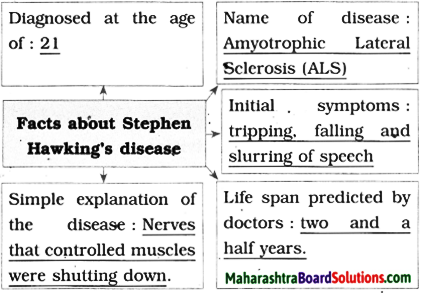
Question 37.
Complete the following:
(a) A decade is a period of ………………….
(b) ……………. refers to the formless matter supposed to have existed before the creation of the universe.
(c) To ……………. one’s speech is to speak (words) indistinctly so that the sounds run into one another.
Answer:
(a) 10 years.
(b) Chaos
(c) slur
Question 38.
The Grand Design was Hawking’s first major publication in almost a decade.
Answer:
The Grand Design was Hawking’s first major publications in almost a decade.
Question 39.
Hawking first began to notice problems with his physical health while he was at Oxford.
(Frame a ‘Wh-’ question to get the underlined part as answer.)
Answer:
When did Hawking first begin to notice problems with his physical health?
Question 40.
He would trip and fall or slur his speech. (Rewrite using ‘not only … but also …’.)
Answer:
He would not only trip and fall but also slur his speech.
![]()
Question 41.
He didn’t look into the problem until 1963. (Rewrite without ‘didn’t’.)
Answer:
He avoided looking into the problem until 1963.
Question 42.
(1) You must have suffered from some illness or sickness. Mention two or three symptoms.
That I was an atypical case.
Answer:
Once I suffered from a viral infection of the throat. It began with a slight irritation in the throat. Then there was pain and I found difficulty in swallowing food and even water. I developed high fever, a runny nose and even had fits of shivering. I visited a doctor’ who confirmed the illness and who prescribed tablets for the cure.
(2) Explain in your own words the following statement made by Stephen Hawking
That I was an atypical case.
Answer:
Stephen Hawking describes how after undergoing a series of tests at the hospital, it became clear that he had a physical condition called Amyotrophic Lateral Sclerosis (ALS). In fact, the doctors made it clear that his was a very unusual case, and not representative of a type, group or class.
Question 43.
(1) The following incidents in Stephen Hawking’s life are given in jumbled order. Arrange the incidents in proper sequence as per their order of occurrence in Hawking’s life
(a) At college, Hawking was bored with life.
(b) Hawking reflected on the condition of the boy suffering from leukemia.
(c) After the diagnosis, Hawking went on to became a noted scientist.
Answer:
(a) Hawking reflected on the condition of the boy suffering from leukemia.
(b) At college. Hawking was bored with life.
(c) After the diagnosis, Hawking went on to became a noted scientist.
Question 44.
In the mid-1970’s what did the Hawking’s family do?
Answer:
In the mid-1970’s, the Hawking family had taken in one of Hawking’s graduate students to help manage his care and work.
Question 45.
What effect did the incidents mentioned below have on Hawking?
(a) Hawking saw a boy in the same room he was in suffering from leukemia.
Answer:
Hawking reflected that his situation seemed more tolerable.
(b) Hawking had a dream that he was going to be executed.
Answer:
Hawking realized that there were still things to do with his life.
![]()
Question 46.
Why was Hawking forced to use a wheelchair?
Answer:
Hawking was forced to use a wheelchair because physical control over his body had diminished becoming completely despondent.
Question 47.
Only those who knew him well could understand him. (Rewrite using ‘no one’.)
Answer:
Other than (Apart from) those who knew him well, no one could understand him.
Question 48.
The resulting situation required 24-hour nursing care for the acclaimed physicist. (Underline the words used as adjectives.)
Answer:
The resulting situation .required 24-hour nursing care for the acclaimed physicist.
Question 49.
Fill in the blanks (The answers are given directly and underlined.)
(a) For 30 years, Stephen Hawking held the post of ………………….
(b) Stephen Hawking selected his words with a ………………..
(c) Stephen Hawking failed to appear at the conference because of a ………………
(d) ……………… remains a constant anxiety.
Answer:
(a) Lucasian Professor of Mathematics at Cambridge.
(b) hand-held clicker.
(c) chest infection.
(d) Hawking’s health
Question 50.
The following incidents in Stephen Hawking’s life are given in jumbled order. Arrange the incidents in proper sequence as per their order of occurrence in Hawking’s life
(a) Hawking was rushed to hospital.
(b) Hawking’s predicament caught the attention of a California computer programmer.
(c) Hawking announced that he was retiring.
Answer:
(a) Hawking’s predicament caught the attention of ; a California computer programmer.
(b) Hawking announced that he was retiring.
(c) Hawking was rushed to hospital.
Question 51.
What do Stephen Hawking’s works include?
Answer:
Stephen Hawking’s works include numerous scientific papers as well as information for the non- scientific community.
![]()
Question 52.
Complete the following.
Answer:
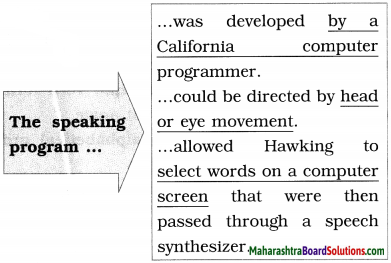
Question 53.
Record the occurrence according to the time chart (The answer is given directly.)
Answer:
2009 – Hawking failed to appear at a conference in Arizona because of a chest infection.
Question 54.
Find evidences of Stephen Hawking’s special life.
Answer:
(a) Hawking used a computer speaking program to select words on a screen that were then passed through a speech synthesizer.
(b) Hawking directed the program through a cheek muscle attached to a sensor.
(c) Hawking had virtually lost all control of his body.
Question 55.
Explain the life of Stephen Hawking with reference to the following statement:
Hawking’s health, of course, remains a constant concern.
Answer:
Due to his physical condition, Hawking’s health is always a source of worry. There are times when his body is not able to cope with the physical challenges of a routine day. There are times when his health deteriorates to such an extent that he has to be rushed to hospital. Despite all this, he continues to share his ideas with the world.
Question 56.
Guess the meaning of predicament.
Answer:
a difficult or unpleasant situation.
Question 57.
Write the adjective forms of:
(a) infection
(b) office.
Answer:
(a) infectious
(b) official.
![]()
Question 58.
Write from the last paragraph phrases that give an indication of Stephen Hawking’s health situation.
Answer:
a constant concern, a worry, rushed to the hospital, ‘gravely ill’, make a full recovery
Question 59.
Underline the determiners. (The answers are given directly and underlined.)
Today, with virtually …………. control of ………….. body gone, Hawking directs ……………. program through ………….. cheek muscle attached to ………… sensor.
Answer:
all
his
the
a
a
Question 60.
Pick out the verbs and state the tense.
(a) Stephen Hawking has continued to write at a prolific rate.
(b) He had already announced he was retiring.
Answer:
(a) has continued – Present perfect
(b) had – announced – Past perfect.
Question 61.
He failed to appear at a conference. (Rewrite using ‘not’.)
Answer:
He did not appear at a conference.
Question 62.
Pick out the prepositions
(a) Hawking directs the program through a cheek muscle attached to a sensor.
(b) He was rushed to the hospital for being what ! the university officials described as being ‘gravely ill’.
Answer:
(a) through, to
(b) to, for, as.
Question 63.
(1) Write two compound words of your own
(2) Pick out the present participle and use it in a sentence He has done groundbreaking work in physics and cosmology.
(3) Spot the errors in the sentence and rewrite the sentence It been translated into many than 40 languages.
(4) Frame a sentence using the given phrase to look into
(5) Identify the sentence Hawking’s health, of course, remains a constant concern.
(6) Write the present participle verb form of the given words (a) simplify, (b) argue
(7) Arrange the words in alphabetical order speech, spontaneous, space, spine
(8) Write two hidden words in the word international
Answer:
(1) noteworthy, worldwide (humankind, handheld)
(2) Present Participle groundbreaking Sentence C V Raman carried out groundbreaking work in the field of light scattering.
(3) It has been translated into more than 40 languages.
(4) The teacher said he would look into the matter of the missing chocolates.
(5) Assertive Sentence.
(6) (a) simplifying (b) arguing
(7) space, speech, spine, spontaneous
(8) inter, intern (nation, national)
![]()
Question 64.
(1) Write a word that sounds the same as the given word and make sentences with both the words allowed
(2) Complete the word chain of nouns from the lesson. cosmology y………….. …………… …………..
(3) Prepare a word register of 4 words for the given word time.
(4) Rewrite using the indirect form of narration. “Because there is a law such as gravity, the universe can and will create itself from nothing,” Hawking said.
Answer:
(1) allowed – He allowed the students to take a break. aloud – He was angry when the student spoke aloud.
(2) cosmology, years, scientist, time, existence
(3) time age, day, date, year, (month, clock, tide, moment, second, present, past, future, term, hour, era, century, interval, tempo, week)
(4) Hawking said that because there was a law such as gravity, the universe could and would create itself from nothing.
Question 65.
(1) Change to the comparative degree It is the highest civilian award in the US.
(2) Use the given word as a noun and verb in sentences focus
Answer:
(1) It is the higher than any other civilian award in the US.
(2) focus (a) After Std. X, you must focus on your career, (verb)
(b) Never lose focus of your goals in life, (noun)
Read More: